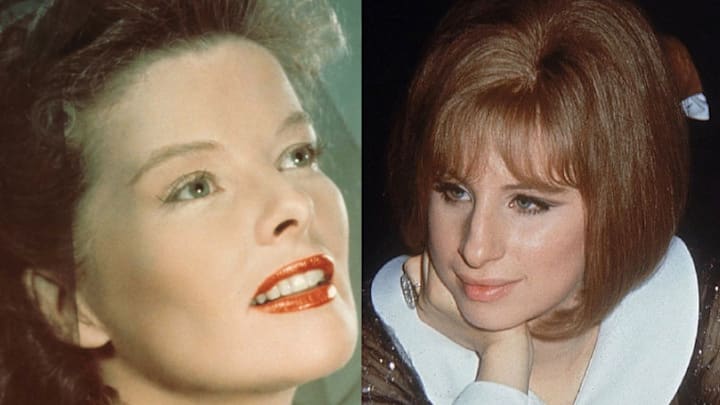Only six ties have ever occurred during the Oscars's more than 90-year history. The Academy of Motion Picture Arts and Sciences (AMPAS) members vote for nominees in their corresponding categories; here are the six times they have come to a split decision.
1. Best Actor // 1932
Back in 1932, at the fifth annual Oscars ceremony, the voting rules were different than they are today. If a nominee received an achievement that came within three votes of the winner, then that achievement (or person) would also receive an award. Actor Fredric March had one more vote than competitor Wallace Beery, but because the votes were so close, the Academy honored both of them. (They beat the category’s only other nominee, Alfred Lunt.) March won for his performance in horror film Dr. Jekyll and Mr. Hyde, and Beery won for The Champ. Both Beery and March were previous nominees: Beery was nominated for The Big House and March for The Royal Family of Broadway. March won another Oscar in 1947 for The Best Years of Our Lives, also a Best Picture winner. Fun fact: March was the first actor to win an Oscar for a horror film.
2. Best Documentary Short Subject // 1950
By 1950, the above rule had been changed, but there was still a tie at that year's Oscars. A Chance to Live, an 18-minute movie directed by James L. Shute, tied with animated film So Much for So Little. Shute’s film was a part of Time Inc.’s "The March of Time" newsreel series and chronicles Monsignor John Patrick Carroll-Abbing putting together a Boys’ Home in Italy. Directed by Bugs Bunny’s Chuck Jones, So Much for So Little was a 10-minute animated film about America’s troubling healthcare situation. The films were up against two other movies: a French film named 1848—about the French Revolution of 1848—and a Canadian film entitled The Rising Tide.
3. Best Actress // 1969
Probably the best-known Oscars tie, this was the second and last time an acting award was split. When presenter Ingrid Bergman opened up the envelope, she discovered a tie between newcomer Barbra Streisand and two-time Oscar winner Katharine Hepburn—both received 3030 votes. Streisand, who was 26 years old, tied with the 61-year-old The Lion in Winter star, who had already been nominated 10 times in her lengthy career, and won the Best Actress Oscar the previous year for Guess Who’s Coming to Dinner. Hepburn was not in attendance, so all eyes fell on Funny Girl winner Streisand, who wore a revealing, sequined bell-bottomed-pantsuit and gave an inspired speech. “Hello, gorgeous,” she famously said to the statuette, echoing her first line in Funny Girl.
4. Best Documentary Feature // 1987
The March 30, 1987 telecast made history with yet another documentary tie, this time for Documentary Feature. Oprah presented the awards to Brigitte Berman’s film about clarinetist Artie Shaw, Artie Shaw: Time is All You’ve Got, and to Down and Out in America, a film about widespread American poverty in the ‘80s. Former Oscar winner Lee Grant (who won the Best Supporting Actress Oscar in 1976 for Shampoo) directed Down and Out and won the award for producers Joseph Feury and Milton Justice. “This is for the people who are still down and out in America,” Grant said in her acceptance speech.
5. Best Short Film (Live Action) // 1995
More than 20 years ago—the same year Tom Hanks won for Forrest Gump—the Short Film (Live Action) category saw a tie between two disparate films: the 23-minute British comedy Franz Kafka’s It’s a Wonderful Life, and the LGBTQ youth film Trevor. Doctor Who star Peter Capaldi wrote and directed the former, which starred Oscar nominee Richard E. Grant as Kafka. The BBC Scotland film envisions Kafka stumbling through writing The Metamorphosis.
Trevor is a dramatic film about a gay 13-year-old boy who attempts suicide. Written by James Lecesne and directed by Peggy Rajski, the film inspired the creation of The Trevor Project to help gay youths in crisis. “We made our film for anyone who’s ever felt like an outsider,” Rajski said in her acceptance speech, which came after Capaldi's. “It celebrates all those who make it through difficult times and mourns those who didn’t.” It was yet another short film ahead of its time.
6. Best Sound Editing // 2013
The latest Oscar tie happened in 2013, when Zero Dark Thirty and Skyfall beat Argo, Django Unchained, and Life of Pi in sound editing. Mark Wahlberg and his animated co-star Ted presented the award to Zero Dark Thirty’s Paul N.J. Ottosson and Skyfall’s Per Hallberg and Karen Baker Landers. “No B.S., we have a tie,” Wahlberg told the crowd, assuring them he wasn’t kidding. Ottosson was announced first and gave his speech before Hallberg and Baker Landers found out that they were the other victors.
It wasn’t any of the winners' first trip to the rodeo: Ottosson won two in 2010 for his previous collaboration with Kathryn Bigelow, The Hurt Locker (Best Achievement in Sound Editing and Sound Mixing); Hallberg previously won an Oscar for Best Sound Effects Editing for Braveheart in 1996, and in 2008 both Hallberg and Baker Landers won Best Achievement in Sound Editing for The Bourne Ultimatum.
Ottosson told The Hollywood Reporter he possibly predicted his win: “Just before our category came up another fellow nominee sat next to me and I said, ‘What if there’s a tie, what would they do?’ and then we got a tie,” Ottosson said. Hallberg also commented to the Reporter on his win. “Any time that you get involved in some kind of history making, that would be good.”
